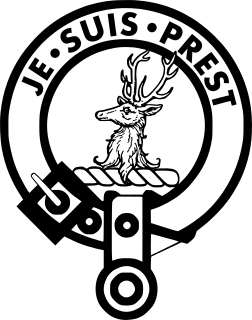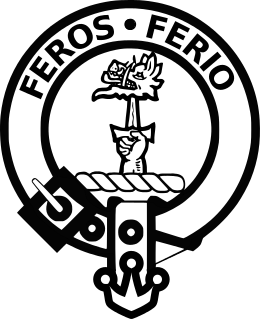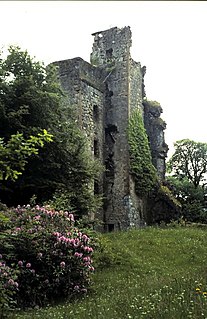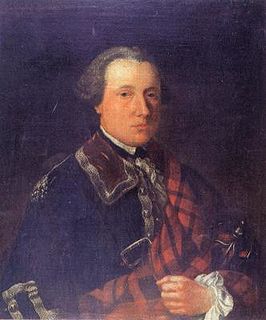
The Highlands is a historic region of Scotland. Culturally, the Highlands and the Lowlands diverged from the later Middle Ages into the modern period, when Lowland Scots replaced Scottish Gaelic throughout most of the Lowlands. The term is also used for the area north and west of the Highland Boundary Fault, although the exact boundaries are not clearly defined, particularly to the east. The Great Glen divides the Grampian Mountains to the southeast from the Northwest Highlands. The Scottish Gaelic name of A' Ghàidhealtachd literally means "the place of the Gaels" and traditionally, from a Gaelic-speaking point of view, includes both the Western Isles and the Highlands.

Flora MacDonald ; was a member of the Macdonalds of Sleat, who helped Charles Edward Stuart evade government troops after the Battle of Culloden in April 1746. Her family supported the government during the 1745 Rising and Flora later claimed to have assisted Charles out of sympathy for his situation.

Inverness colloquially known as "Inversnecky" is a city in the Scottish Highlands. It is the administrative centre for The Highland Council and is regarded as the capital of the Highlands. Historically it served as the county town of the county of Inverness-shire. Inverness lies near two important battle sites: the 11th-century battle of Blàr nam Fèinne against Norway which took place on the Aird, and the 18th century Battle of Culloden which took place on Culloden Moor. It is the northernmost city in the United Kingdom and lies within the Great Glen at its northeastern extremity where the River Ness enters the Beauly Firth. At the latest, a settlement was established by the 6th century with the first royal charter being granted by Dabíd mac Maíl Choluim in the 12th century. The Gaelic king Mac Bethad Mac Findláich (MacBeth) whose 11th-century killing of King Duncan was immortalised in Shakespeare's largely fictionalised play Macbeth, held a castle within the city where he ruled as Mormaer of Moray and Ross. Inverness and Inverness-shire are closely linked to the Clan MacKenzie.

Blair Castle stands in its grounds near the village of Blair Atholl in Perthshire in Scotland. It is the ancestral home of the Clan Murray, and was historically the seat of their chief, the Duke of Atholl, though the current (12th) Duke, Bruce Murray, lives in South Africa. The castle stands in Glen Garry, and commands a strategic position on the main route through the central Scottish Highlands.

The Battle of Cromdale took place at the Haughs of Cromdale on 30 April and 1 May 1690. The site is on a hillside near the village of Cromdale, then in Inverness-shire and now in the Highland council area. The battlefield has been included in the Inventory of Historic Battlefields in Scotland and protected by Historic Scotland under the Scottish Historical Environment Policy of 2009.

John Pettie was a Scottish painter who spent most of his career in England. He became a member of the Royal Academy in 1866 and a full academician in 1874.

Clan Fraser of Lovat is a Highland Scottish clan. The Clan Fraser of Lovat has been strongly associated with Inverness and the surrounding area since the Clan's founder gained lands there in the 13th century, but Lovat is in fact a junior branch of the Clan Fraser who were based in the Aberdeenshire area. Both the Clan Fraser and the Clan Fraser of Lovat have their own separate clan chiefs who are recognized by the Lord Lyon King of Arms under Scottish law. The Clan Fraser of Lovat in Inverness-shire has historically dominated local politics and been active in every major military conflict involving Scotland. It has also played a considerable role in most major political turmoils. "Fraser" remains the most prominent family name within the Inverness area.

Clan Rose is a Scottish clan of the Scottish Highlands.

Clan Chisholm is a Highland Scottish clan.

Archibald Campbell Fraserof Lovat, was British consul at Tripoli and Algiers, and later colonel of the 1st Inverness local militia. Upon the death of his brother, Simon Fraser (1726–1782), Archibald became the 20th MacShimidh (chief) of Clan Fraser of Lovat, and sat in the House of Commons from 1782 to 1784.

Invergarry Castle in the Scottish Highlands was the seat of the Chiefs of the Clan MacDonell of Glengarry, a powerful branch of the Clan Donald.

Donald Cameron of Lochiel, was hereditary chief of Clan Cameron, traditionally loyal to the exiled House of Stuart. His father John was permanently exiled after the 1715 Rising and when his grandfather Sir Ewen Cameron died in 1719, Donald assumed his duties as 'Lochiel.'

The siege of Fort William took place in the Scottish Highlands during the 1745 Jacobite Rising, from 20 March to 3 April 1746.

The Battle of Littleferry took place during the Jacobite rising in 1746, just before the Battle of Culloden. Scottish forces loyal to the British-Hanoverian Government defeated a rebel Scottish Jacobite force.

The West Highland Museum tells the story of the Scottish Highlands and the Islands. It aims to cover every aspect of West Highland history, including that of Fort William, where it is located in a listed building in the centre of the town. It also hosts other exhibits for archaeology and wildlife. The museum, which has always been independent, is a member of Museums Galleries Scotland.

The siege of Inverness took place in February 1746 and was part of the Jacobite rising of 1745.
The Independent Highland Companies were irregular militia raised from the Scottish clans of the Scottish Highlands by order of the Government between 1603 and 1760 in order to help keep the peace and enforce the law in the Highlands, and were officially recognized as such by the Government. The officers of the Independent Highland Companies were commissioned as officers of the British Army, but the companies themselves were not recognized as official regiments of the line of the army. The Independent Highland Companies were the progenitors of the world-famous Highland Regiments of the British Army that began when ten Independent Highland Companies were embodied to form the Earl of Crawford's Highland Regiment that was numbered the 43rd Regiment of Foot in 1739.

Lochalsh is a district of mainland Scotland that is currently part of the Highland council area. It is a hilly peninsula that lies between Loch Carron and Loch Alsh. The main settlement is Kyle of Lochalsh, located at the entrance to Loch Alsh, opposite the village of Kyleakin on the adjacent island of Skye. A ferry used to connect the two settlements but was replaced by the Skye Bridge in 1995.

The Atholl raids of 14 - 17 March 1746 were a series of raids carried out by Jacobite rebels against the British-Hanoverian Government during the Jacobite rising of 1745.

The siege of Culloden House took place on the night of 15/16 October 1745 and was part of the Jacobite rising of 1745. 200 men of the Jacobite Clan Fraser of Lovat attempted to capture Duncan Forbes, Lord Culloden who was the Lord President of the Court of Session, the most senior legal officer in Scotland.




















